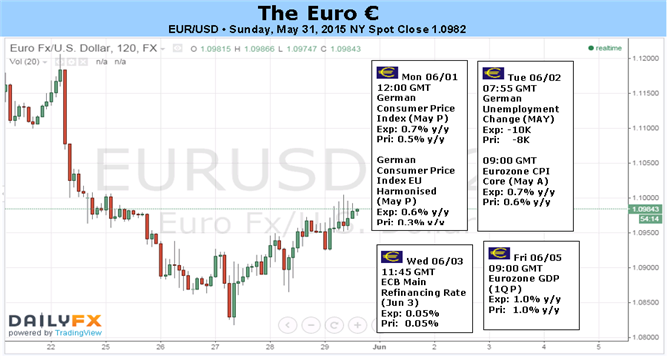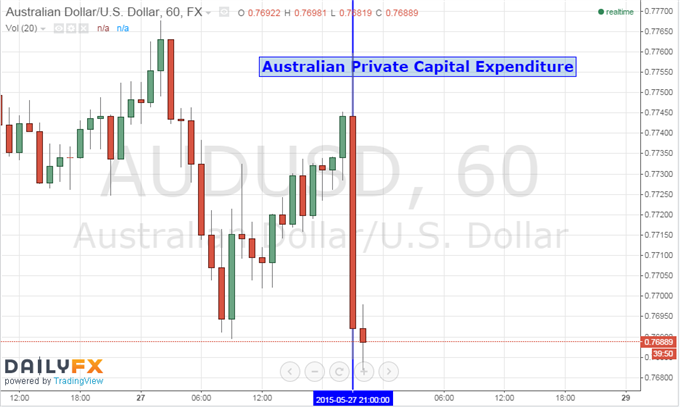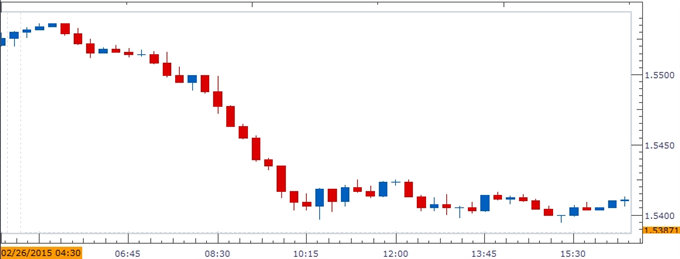By Christopher Vecchio, Currency Strategist

Fundamental Forecast for Euro:Neutral
- EURUSD appears to have made a significant turn on the charts…
- …and recent gains seen in EURUSD may be setting up a ‘sell the rally’ opportunity.
- Have a bullish (or bearish) bias on the Euro, but don’t know which pair to use? Use a Euro currency basket.
While EURUSD
was pressured into fresh monthly lows just above $1.0800, a late-week
rally in the EUR-crosses wiped out nearly all losses accumulated earlier
across the spectrum. Dodging disparaging headlines about Greece’s
ability to reach consensus with her creditors, EURUSD only closed -0.10%
lower at $1.0990, while EURAUD and EURJPY led the EUR-crosses higher by +2.22% and +2.02%, respectively.
The Euro’s sensitivity to the situation in Greece is
bound to jump in the coming days, even if only temporarily, as a June 5
deadline for a payment to the IMF looms. This is a delicate situation
insofar as the Greece government is purportedly open to defaulting on
her obligations in order to maintain its political party’s pre-election
promises. As far as the impact of the intraday headlines on the Euro,
the likelihood remains low; but the ever so important tail risk scenario
is becoming more probable, likely to leave traders a bit uneasy.
Of course, in the background, the ECB’s QE-driven
trade – via the portfolio rebalancing channel effect – is dictating
asset performances across the risk spectrum. In tandem, European
sovereign yields are falling, the Euro is depreciating, and European
equity markets are rallying (or vice-versa). This trilateral
relationship should continue to persists, irrespective of the Euro’s
direction.
In the very near-term, there is heightened risk to
the Euro (and more specifically, EURUSD) as a calendar packed with
medium- and high-ranked event risk is on the horizon. Event-driven
volatility – particularly between the hours of 08:30 GMT to 14:00 GMT –
will be well-represented this coming week.
On Monday, the German Consumer Price Index for May
and the May US ISM Manufacturing survey are due. On Tuesday, May German
labor market data and the May Euro-Zone CPI will be released, as well as
US Factory Orders for April. On Wednesday, the ECB will hold its June
interest rate meeting and press conference, while the May US ADP
Employment Change report, the May US ISM Services gauge, and the Fed’s
Beige Book will be released. On Thursday, the May PMI readings for the
Euro-Zone and Germany, and the weekly US jobless claims data will be
released. Lastly, on Friday, Q1’15 Euro-Zone GDP data will be released,
while the May US Nonfarm Payrolls report and unemployment rate wil be
due.
Needless to say, there are items on the calendar
over the next few days on both sides of the pond that are likely to
increase volatility around EURUSD. Besides previously discussed
influences lingering in the background – Greece and the ECB’s QE program
– the one theme that will be put to the test this week, that could
drive the direction of EURUSD for the coming weeks, will be the notion
that the US economy has reversed its early-year slowdown. Only if the
recent optimism over the US growth story in Q2’15 is confirmed by the
upcoming data, will the rising interest rate differentials in favor of
the US Dollar
story take hold. By the end of the week, we should have a better idea
of which way EURUSD will be trading for the foreseeable future. –CV










